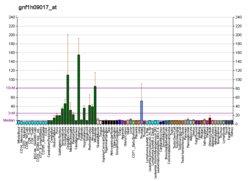| CPNE4 |
|---|
|
| Identifiers |
|---|
| Aliases | CPNE4, COPN4, CPN4, copine 4 |
|---|
| External IDs | OMIM: 604208; MGI: 1921270; HomoloGene: 26078; GeneCards: CPNE4; OMA:CPNE4 - orthologs |
|---|
| Gene location (Human) |
|---|
 | | Chr. | Chromosome 3 (human)[1] |
|---|
| | Band | 3q22.1 | Start | 131,533,555 bp[1] |
|---|
| End | 132,285,410 bp[1] |
|---|
|
| Gene location (Mouse) |
|---|
 | | Chr. | Chromosome 9 (mouse)[2] |
|---|
| | Band | 9|9 F1 | Start | 104,424,485 bp[2] |
|---|
| End | 104,911,743 bp[2] |
|---|
|
| RNA expression pattern |
|---|
| Bgee | | Human | Mouse (ortholog) |
|---|
| Top expressed in | - lateral nuclear group of thalamus
- myocardium of left ventricle
- endothelial cell
- primary visual cortex
- Brodmann area 23
- palpebral conjunctiva
- dorsolateral prefrontal cortex
- Brodmann area 9
- Brodmann area 46
- right ventricle
|
| | Top expressed in | - dentate gyrus of hippocampal formation granule cell
- lumbar spinal ganglion
- hippocampus proper
- trigeminal ganglion
- primary visual cortex
- habenula
- superior frontal gyrus
- olfactory bulb
- temporal lobe
- glossopharyngeal ganglion
|
| | More reference expression data |
|
|---|
| BioGPS |  | | More reference expression data |
|
|---|
|
| Gene ontology |
|---|
| Molecular function | - protein binding
- calcium-dependent phospholipid binding
| | Cellular component | - extracellular exosome
- plasma membrane
| | Biological process | - cellular response to calcium ion
| | Sources:Amigo / QuickGO |
|
| Orthologs |
|---|
| Species | Human | Mouse |
|---|
| Entrez | | |
|---|
| Ensembl | | |
|---|
| UniProt | | |
|---|
| RefSeq (mRNA) | |
|---|
NM_001289112
NM_130808
NM_153429
NM_001388326
NM_001388327 |
| |
|---|
NM_028719
NM_001357439
NM_001378996 |
|
|---|
| RefSeq (protein) | NP_001276041
NP_570720
NP_702907
NP_001276041.1
NP_570720.1
|
|---|
NP_702907.1 |
| |
|---|
NP_082995
NP_001344368
NP_001365925 |
|
|---|
| Location (UCSC) | Chr 3: 131.53 – 132.29 Mb | Chr 9: 104.42 – 104.91 Mb |
|---|
| PubMed search | [3] | [4] |
|---|
|
| Wikidata |
| View/Edit Human | View/Edit Mouse |
|

















